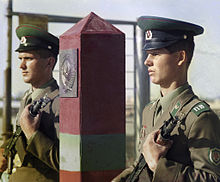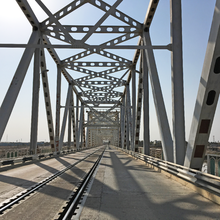Afghanistan-Uzbekistan Friendship Bridge
Coordinates: 37 ° 13 ′ 44 ″ N , 67 ° 25 ′ 40 ″ E
| Friendship Bridge | ||
|---|---|---|
| use | Railway and road bridge | |
| Crossing of | Amu Darya | |
| place |
near Termiz , Uzbekistan Hairatan , Afghanistan |
|
| construction | Truss bridge | |
| overall length | 816 m | |
| width | 15 m | |
| Number of openings | nine | |
| Longest span | 90 m | |
| start of building | 1980 | |
| opening | 1982, 2001 | |
| closure | 1997-2001 | |
| location | ||
|
|
||
The Bridge of Friendship is a combined rail and road bridge over the Amu Darya , which forms the border between Afghanistan and Uzbekistan . It connects the Uzbek city of Termiz, about 12 km downstream, with the Afghan town of Hairatan . It is the only bridge along the 135 km long border between these two countries.
The closest bridge upriver is the Tajikistan – Afghanistan bridge over the Pandsch between Pandschi Pojon and Shir Khan Bandar north of Kunduz. Approx. 120 km downstream is a pipeline bridge in the form of a suspension bridge near the Turkmen town of Kelif. The closest road and rail bridges are in the Turkmen town of Kerki , 200 km away as the crow flies .
The approximately 816 m long and 15 m wide bridge consists of nine steel lattice girders with spans of 90 m each.
The broad-gauge railway line crossing the bridge , which is connected to the Russian railway network through Uzbekistan and Kazakhstan , ended for decades immediately south of the bridge in the Afghan border town of Hairatan. In January 2010 the construction of the extension to Mazar-e-Sharif over 75 kilometers started and was completed in November 2010.
history
The bridge was built between 1980 and 1982 by the Soviet Army to supply their troops during the intervention in Afghanistan . The opening ceremony took place on May 12, 1982.
On February 15, 1989, the last Soviet troops withdrew from Afghanistan, with Lieutenant General Boris Vsevolodowitsch Gromov being the last Soviet soldier to cross the northern half of the bridge on foot.
The bridge was closed in May 1997 after the Taliban captured large parts of Afghanistan and launched an attack on the city of Mazar-e Sharif , and Uzbekistan feared the conflict would spread to its territory.
After negotiations between the then Secretary of State of the United States Colin Powell and Islom Karimov , the President of Uzbekistan, the reopening took place on December 9, 2001 with a train full of relief supplies for Afghanistan, which was later followed by a convoy of Russian trucks also loaded with relief supplies.
See also
Web links
Individual evidence
- ^ A b Hairatan and the Friendship Bridge on Railways of Afghanistan , a website by Andrew Grantham
- ^ Construction of Afghan railway launched . Railway Gazette International , January 27, 2010. Retrieved April 4, 2010.
- ↑ Bundeswehr in Afghanistan receives railway connection blog from November 17, 2010 in Russia News
- ↑ Thomas Ruttig: Crossing the Bridge: The 25th anniversary of the Soviet withdrawal from Afghanistan on Afghanistan Analysts Network.
- ↑ Jürgen Gottschlich: The bridge to the front. Article of November 6, 2001 in Die Weltwoche
- ^ Breakthrough in Afghan aid effort. BBC News dated December 9, 2001



